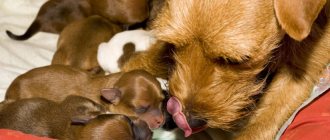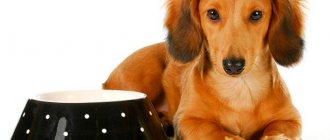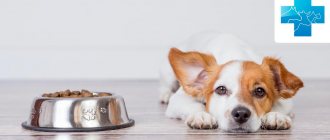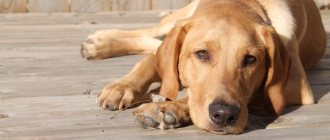Proper feeding of a nursing bitch that has given birth is the key not only to her health, but also to the well-being of the entire litter. That is why every owner, especially if he has witnessed the birth of puppies for the first time, should know what to feed the dog after birth.
The diet of a lactating bitch determines the quality of her milk, but even if, after giving birth, the dog for some reason refused to feed the puppies, it is important to restore the body that was damaged after pregnancy. It is important to understand that the period of gestation of puppies is not only a natural process, but also a lot of stress for any dog. Therefore, today we will discuss how to create a diet suitable for a bitch who has given birth during the postpartum period, during lactation.
What to feed your dog after giving birth?
Why is it important?
After the birth of the offspring, the dog's behavior will change. The awakened maternal instinct is so great that it overshadows all others, even hunger. The mother will not leave her babies, so you should set up a feeding area not far from the bed. There should always be a feeder with food nearby, a bowl of clean water, and you can pour milk.
In the first few days after birth, the pet eats sluggishly and may completely refuse to eat. In the future, the nursing mother's appetite will only increase. And the more puppies are born, the higher the need for food. Feeding a dog after giving birth is significantly different from its usual diet. Now preference is given only to natural, healthy products.
If your pet has eaten the placenta (the place where babies grew), then she will need food in 5-6 hours. These small sacs look like a piece of liver. Their tissues contain a large amount of proteins, fluids and beneficial microelements that the dog needs for recovery. The dog eats the placenta instinctively, but may refuse. Some dog breeders consider this harmful and remove children's places, preventing the bitch from absorbing them.
Under natural conditions, canids give birth to no more than 4 cubs. Their domestic relatives may have twice as many puppies. Eating this much afterbirth will cause diarrhea lasting up to three days. Antibiotics and other medications should not be given to a nursing dog. It is better to choose ways to combat indigestion that are less harmful to children:
- herbal decoctions;
- gastric lavage;
- probiotics;
- Activated carbon.
Until digestion improves, for the first 2-3 days you will have to carefully think through what to feed the dog after giving birth. You should include light, low-fat foods in your diet so as not to complicate the situation. It is advisable to grind or puree it. Steamed rice porridge helps a lot. The ground cereal is poured with boiling water, wrapped and left for 6 hours. It can be prepared in advance and stored in the refrigerator (up to 2 days).
Useful video
Watch this video about artificial feeding of puppies and kittens:
Proper feeding in the postpartum period is important for both the bitch and the pups: it quickly restores the dog’s body, has a good effect on lactation and the quality of milk, and on the health of the puppies.
And in the case when the attitude towards the “mom’s” nutrition is inattentive, she may develop a lack of calcium, which will lead to eclampsia.
We will consider in detail how and what to feed a dog after giving birth.
Contractions are a process that affects all systems of the body, and it should be alleviated as much as possible. And a full stomach makes contractions more difficult.
And the reasons for this are as follows:
- the dog’s body temperature drops, which leads to a slowdown in metabolism and interruption of digestion (therefore, bitches at this time refuse to eat themselves);
- the first born puppy is the largest, and advancement through the birth canal is more difficult if the “mommy’s” intestines are full;
- contractions for a well-fed dog are more difficult than for a hungry dog and last longer;
- If a bitch gives birth on a full stomach, she may vomit or have involuntary bowel movements, both of which are stressful for her.
Diet for eclampsia
Pugs and Jack Russell Terriers often develop eclampsia after giving birth. This disease occurs due to a lack of calcium in the body. The main symptoms of the disease include:
- increased body temperature;
- shortness of breath and increased heart rate;
- deterioration of coordination and loss of balance;
- weakness, due to which the dog may be unconscious;
- loss of appetite;
- dilated pupils;
- convulsions.
Important! If the above symptoms appear, you need to call a veterinarian to come and examine the dog.
During treatment of eclampsia, it is better to exclude solid foods from the diet. Instead, the pet is given more broths and soups.
What is important to get with food?
A nursing bitch should eat her fill. She needs to be fed 6-7 times a day in small portions. During lactation, the dog needs to receive a sufficient amount of nutrients:
- proteins;
- carbohydrates;
- minerals;
- fats;
- vitamins
Calcium and drinking plenty of fluids are important for nursing mothers. The body uses a lot of fluid to produce milk, so its reserves should be replenished regularly. Milk, herbal decoctions (lemon balm, oregano), tea with milk and cream with a fat content of 10% help lactation. The dog should drink every 3 hours at a minimum. In case of refusal, fill it in by force.
Animal bones are another excellent source of calcium and other minerals. But when consuming them, there is a risk of injuring something in the oral cavity or intestines. Therefore, we recommend it - a worthy bone substitute, even more micro- and macroelements, lasts longer.
Attention! You can trick your dog by dissolving a small piece of butter in a warm drink. Its smell will attract the bitch and provoke her to drink what is offered.
Fans of dry food will have a hard time. Such food takes a lot of fluid necessary for lactation, so from the first weeks of pregnancy dry food should be removed from the diet
.
The dog's diet after giving birth in the first 10 days should consist of light, easily digestible food: cereals, omelettes, vegetable soups, pates. It is better to avoid animal proteins during this period. Season porridge with vegetable oil, replace meat with fish and offal. Be sure to give cottage cheese - a source of calcium.
Natural or dry food
Natural products, when used correctly, are an excellent solution, but require a lot of time and attention from the owner. Because of this, dry ready-made food was invented, which is designed to relieve dog owners from the constant headache of choosing food.
Feeding table scraps does not provide the animal with all the nutrients it needs.
Dry mixtures come in three classes:
- economy;
- premium;
- super premium.
The first type of food is made from low-quality products and soy, which is why when using them they need to be supplemented with amino acids and vitamins. These foods are poorly digestible by dogs. 100 g of this mixture contains about 250 kcal.
Premium food contains meat products; no soy is used in their production, and therefore the energy value is about 300 kcal. A representative of premium food is ABBA, which you can read about here.
Super premium dry food is well absorbed by the dog’s body due to its excellent balance and high calorie content. A wide variety of meats are used in their production, including turkey, rabbit, and plant products. 100 g of product contains up to 450 kcal, which is why much less is required in food.
An obvious advantage of natural food is the presence of nutrients in it.
Postpartum feeding of the dog by week
The health of her and her puppies directly depends on the quality of the products and the correctness of the diet of the lactating bitch. An unbalanced, low-calorie diet can lead to exhaustion in dogs or starvation in babies. As feeding progresses, the amount of food needed changes. Let's look at the dog's approximate diet for the entire feeding period.
First week
In the first 2-3 days, it is better to cook porridge for the dog (rice, oatmeal, buckwheat, wheat). Dairy milk is possible if there is no disorder. First, boil the cereal in water, then add milk and boil for another 5 minutes. Be sure to include dairy products in your diet:
- whole milk;
- cottage cheese;
- kefir;
- cheeses.
Lean meat should be introduced only after 5 days, gradually, starting with broths. You can give any pasta, low-fat fish (cod, pollock, hake). All foods must be cooked. They cannot be offered raw. This is especially true for vegetables or juices. Such experiments will lead to diarrhea in the cubs. The portion is increased by one and a half times the usual norm.
Second week
Starting from the second week, the nursing dog’s menu includes soups based on meat broth with the addition of vegetables and cereals. On days 10-12, the bitch is offered a small piece of raw meat, but without bones. It is necessary to ensure that the daily intake of nutrients is within the following limits:
- fiber - 70 grams;
- fats - 20 grams;
- proteins - 90 grams;
- light carbohydrates - 150 grams.
The serving size doubles.
Important! Observing the behavior of puppies will help determine whether the dog is getting enough food. Well-fed babies are calm and sleep a lot, but hungry babies squeak and lean on their nipples. In this case, it is necessary to increase the amount of food for the nursing mother.
Third week
It's time to add more portions and diversify the menu, because the kids have grown up and want more milk. A threefold increase will be just right. The menu is supplemented with bone meal, fresh vegetables and juices, and herbs. A vitamin complex and a mineral mixture will not be superfluous; it is allowed to give the dog ascorbic acid with glucose. To maintain or enhance lactation, use the drug Apilak, a coffee drink or tea with milk and a drop of honey, or a walnut.
Fourth week
As a rule, dogs nurse their young for 4-6 weeks. The puppies will soon begin to feed on their own, so the mother will have less and less milk. It's time to reduce the amount of food and liquid. The portion should gradually return to prenatal sizes. Until the complete cessation of lactation, you should not reduce the caloric content of food.
How long lactation lasts depends not only on nutrition, but also on the characteristics of the body. The more milk the dog produces, which is sucked by the puppies, the more abundant the food should be. Conversely, you should not feed a bitch who does not feed her babies well. Dog food needs to be salted; the need for salt increases during lactation.
All pets, especially nursing dogs, need 24/7 access to filtered water. To provide your pet with the opportunity to drink whenever he wants, we recommend that the water will circulate and be enriched with oxygen all the time.
How to restore an animal after birth and feeding
Bearing puppies, giving birth, and feeding require a lot of energy from the pet. To restore the body, high-quality nutrition for the dog is important even after the end of lactation. A complex of vitamins, which include fatty acids, sulfur, and seaweed, will not be superfluous.
You need to pay attention to the mammary glands. During the feeding process, cracks and injuries from the teeth appeared, which causes pain and discomfort. To solve this problem there are special gels, ointments and pastes. Physical activity for the dog is introduced gradually, and examinations by a veterinarian are carried out regularly.
Complete, high-quality nutrition for a lactating bitch is a guarantee of the health of the pet and her cubs. Together with mother's milk, babies receive “building material” for growth and strong immunity for the future. In addition, a balanced diet will help solve the issue of how to restore a dog after birth and feeding.
During childbirth or immediately after it, the bitch eats the remaining placenta. Some breeders remove them before she can do it, but most still tend to allow what is inherent in nature. The tissues of the placenta contain many nutrients and beneficial substances, so this will not cause any harm to her. The only thing that threatens the animal is light. But this is for the best - in this case, the dog will not have to strain too much when defecating.
If the placenta has been eaten, the next time the bitch needs to be fed after 4-5 hours. In the first few feedings, you can give crushed rice, which must first be soaked for 8-12 hours, then boiled with boiling water and a little salt and vegetable oil added to the mixture. This food will help the dog get rid of. In the first days after birth, the animal’s diet should not contain animal proteins, which will not yet be well absorbed. The diet should consist of various cereals, fresh, not very fatty cottage cheese, omelettes, and 10% fat cream. The dog should eat 5-6 times a day, it should not starve, but don’t let it overeat either. Give her water at least every 3 hours, give her fresh raw water and milk.
After birth, while feeding the puppies and for several weeks after that, the dog’s diet should contain a lot of dairy products, their amount should prevail over meat.
About visiting the veterinarian
Puppies are vulnerable in the first weeks after birth. Everything is passed on to them through their mother's milk, and diseases develop in them much faster than in an adult dog. And if medical assistance is not provided as soon as possible, the outcome will be disastrous.
Hence the importance of the health of the bitch, which also becomes vulnerable after giving birth and during feeding. And in order not to lose either the “mommy” or the litter, it is better to contact a veterinarian in time.
In conclusion, we can say that proper, balanced nutrition for a dog and adherence to a feeding regimen are the most important factors not only for maintaining its health, but also for the development and growth of strong, healthy, strong puppies. And let these kids be worthy of the title of the largest or most beautiful dogs.
Additionally, we suggest you watch a video about feeding and behavior of a bitch in the first days after giving birth:
How to stimulate milk production in a pregnant bitch
The question is relevant not only for dogs. First, make sure that such stimulation is necessary.
The main sign of a lack of milk or its insufficient nutrition will, of course, be hungry puppies. They will get restless, crawl around and squeak.
The mother will feed them reluctantly, constantly being distracted by extraneous stimuli, and will constantly try to leave. This behavior is associated with a lack of milk and sore nipples when trying to feed.
What needs to be done to ensure that a dog that has given birth produces more milk. This can be done in several ways.
- Introduce liquid foods, fermented milk products (fermented baked milk, yogurt, etc.) into the diet and be sure not to limit drinking water and monitor its purity.
- Physical stimulation of nipples and mammary glands. Light massage of the mammary glands and even pumping trigger the production of oxytocin in the brain, the hormone responsible for the process of milk production. When puppies suck milk, they massage the mammary gland with their paws, and the nipple itself with their mouth (babies do this in almost all mammals, including humans). In dogs, as a rule, the last pair of nipples is more productive, so it makes sense to place the weakest puppies on them first, and the strongest ones on the first pair, so that the puppies develop them “stronger”. After the weak ones have had their fill, they can be swapped with the strong ones.
- Introduce walnuts into your dog's diet - 1 walnut three times a day, crushed, along with food, as a medicine.
- Application of the biostimulator "Apilak". This is a medical product that has contraindications. Before using it, you must, at a minimum, read the instructions, and at maximum, consult a veterinarian.
- Apply hormonal therapy. This method can only be performed by an experienced veterinarian. Self-medication in this way is unacceptable.
Feeding in the following days
Animal fats can begin to be introduced into the bitch’s diet on the 8-10th day; it is better if these are by-products. Add heart and liver, cut into small pieces, to porridges and soups along with a small amount of fresh vegetables. From now on, soups for her can also be cooked in meat broths. Diversify your dog's diet by alternating dairy and meat feedings, adding raw vegetables and fruits, cut into pieces or grated, if he eats them along with porridge.
After giving birth, the bitch's food must be supplemented with ground eggshells, special vitamin complexes, rehydron and other mineral supplements.
Please note that lactation lasts only 6 weeks; by the end of the 5th week, the amount of milk decreases noticeably. Therefore, until this time, the amount of food that you give the dog should constantly increase - after all, the amount of milk sucked also becomes greater. Then, after you start feeding the puppies, gradually reduce the portions of food for the bitch. After the puppies have been weaned, feed her 3 times a day, and after some time, switch to the usual once or twice a day feeding regimen.
Has your dog given birth? Congratulations! Now you have to take care of the tiny puppies, but also not forget about their mother.
Once dogs are done giving birth, they need the right variety of food to make the milk more nutritious to feed their offspring. Your pet's food should contain a sufficient amount of calories, vitamins, and minerals.
After giving birth, a mother dog sometimes refuses to eat or her appetite decreases. This happens because the dog eats the placenta (the placenta with the membrane of the fetus).
But for three weeks she needs to be fed 2 times more than usual. Owners most often do not know how and what a dog should eat after giving birth.
It is very necessary and important to offer your dog healthy food in the first hours. At this moment, she needs more liquid food than usual. You can offer her:
- various grain porridges;
- cottage cheese or other fermented milk products;
- omelette.
It is necessary to feed in small portions. She should eat 6-7 times a day.
Drinking plenty of fluids plays a very important role. After all, the dog needs to produce milk for the puppies, and in the process, fluid in the body is lost. It is necessary to give water or milk every 3 hours. Cream is also useful.
Weight Gain Products
If in normal home conditions the dog has suddenly lost weight, you should immediately look into this problem. This can occur due to illness or poor nutrition. Once the cause of weight loss has been diagnosed or prevented, the next step should be normalization of nutrition.
The first and most important product for any natural-fed dog should be meat. It contains essential amino acids that cannot be obtained from plant foods. It should be thermally processed and non-greasy. Harmful varieties, such as pork and lamb, can cause digestive upset. Instead, you should take a closer look at veal, rabbit or turkey. In general, meat ingredients should make up up to 75% of the diet.
Expert opinion
Anna Abramenko
An avid dog lover. Experience in veterinary medicine since 2009.
Ask a Question
Products of plant origin are also needed: buckwheat and rice cereals. It is recommended to cook them in water. Wheat cereals are poorly digestible and cause allergic reactions in some pets.
Do not neglect vegetables and fruits: beets, carrots and apples. If the dog has suffered poisoning or enteritis, food is given in a semi-liquid and mushy state.
This is interesting: 5 fruits that should not be given to a dog
Peculiarities of childbirth in dogs
If your pupil gives birth for the first time, then you should know that this process in animals occurs on an empty stomach. Body temperature decreases the day before labor begins. Metabolism and food digestion also slow down to save energy. It is easier for the first puppy, who is usually the largest, to pass through the birth canal when the mother's intestines are empty. If her stomach is full, then pushing will be much harder. Contractions may trigger vomiting.
The owner must provide the woman in labor with something to drink: broth, low-fat milk, whey - in a word, whatever the dog usually likes. During the birth process, the bitch expels the placenta after giving birth. She instinctively eats them. The birth is complete if within two hours the pet no longer experiences any pushing or contractions and all the placenta has passed away.
Feeding immediately after birth
Sometimes a dog's instinctive eating of afterbirth can result in diarrhea. To prevent it, it is recommended to prepare rice porridge in advance. It can be stored in the refrigerator for two days.
To prepare it, rinse the rice, place it in a tightly sealed container, pour boiling water over it and add a pinch of salt. Wrap the container in a towel and let the rice stand for 6-8 hours. Then puree the steamed cereal with a blender. It is better to give this porridge to a dog with diarrhea in its pure form. But before giving it to your pet, you can dilute it with hot vegetable broth.
If a new mother has diarrhea for several days, then she will only have to be fed this kind of porridge. Monitor the dog's condition, do not leave it alone for a long time. You should not separate the mother from her offspring to go to the veterinarian. If necessary, it is better to call a doctor at home.
Dog's nutritional needs.
Within 10 days you should give up animal proteins, because they are difficult to digest by the body. After this, the diet should be:
- meat, fish, offal – 45%;
- cereals – 30%;
- vegetables - 15%.
The amount of food should first be gradually increased over the course of a month, and then reduced as the mother’s milk decreases. A dog's lactation begins to decrease from the fifth week.
When the puppies are weaned from their mother, the dog is fed three times a day, but milk should continue to be given to her.
Cereals for dogs
Not all cereals are suitable for a dog to eat. Buckwheat is considered one of the most useful. It contains complex carbohydrates, B vitamins, calcium, iron and magnesium. Individuals that eat buckwheat remain full for a long time. It is enough to simply cook the cereal without salt, in a ratio of 1:1.5 with water.
Another recommended porridge is rice, which, in addition to vitamins B and E, contains zinc, iron, calcium and fatty acids. Thanks to its sorbing properties, it is able to remove toxins and waste from the body, which is especially important for animals after poisoning. Excessive consumption of rice, however, leads to constipation.
Oats contain vitamins A, B, E, amino acids, Na, K, Mg ions, as well as healthy fats. Porridge from such cereals is preferable after a dog has been starving for a long time or after inflammatory processes in the gastrointestinal tract, since the gluten it contains can coat the walls and reduce pain. However, this dish causes allergies, so a dog that has never tried it before must first be given a little, and then monitored for 24 hours.
Vitamins and minerals.
A healthy and balanced diet is very important for a dog; it will become more resilient, stronger, and its activity will be at a high level. Lack of vitamins and minerals can affect the health of puppies.
Thus, vitamin A enters the diet of babies only from a nursing mother and is needed for immunity and for the eyes. The same applies to other vitamins.
Owners should very carefully monitor the presence of vitamins in the dog’s food. The lack of minerals leads to diseases of both the mother and the puppies.
Osteoporosis develops, and in children - rickets. A healthy and varied diet is the key to the health of your pet and babies. Nutritious milk improves the immunity of puppies and they grow into healthy and beautiful animals.
The birth of puppies to a dog is a wonderful event; during the feeding period, the owner’s task is to provide the nursing dog with proper care and a varied and healthy diet. After giving birth, the bitch’s weight returns to normal (the deviation from the previous dimensions is usually insignificant - up to 10%).
After giving birth, the animal’s appetite may decrease, so on the first day it is recommended to give cool milk with glucose, more water, and food in small portions (fermented milk products, cereal porridge in low-fat broth). Already on the 3-4th day, the dog’s appetite increases significantly, you can transfer it to an adjusted but familiar diet.
If the dog is accustomed to eating dry or semi-dry food, after birth the serving size is increased by an average of a third. Many manufacturers have series for pregnant and lactating dogs: it is better to choose this food, it is more balanced.
Common mistakes
The most common mistakes that owners make include:
- Feeding domestic dogs fatty meats, which can cause liver problems.
- Eating river fish instead of sea fish. The first contains a large number of parasites.
- Eating chicken by-products such as heads and feet. The former contain a lot of fat, while the latter provoke intestinal perforation.
- Give whole milk. Dogs lack essential enzymes and may develop diarrhea.
- Food too hot. Leads to injury to the gastrointestinal mucosa.
- Excessive salting. There is no need for such food for dogs, since salt, even in small quantities, leads to poisoning.
- Chocolate treat. This sweetness is tantamount to poison and very quickly leads to liver failure and death of the animal.
- Feeding with pasta, bread or semolina. In addition to the fact that these products are made from wheat, to which dogs are often allergic, they contain large amounts of carbohydrates that contribute to obesity.
- Adding onions. The use of this product can cause burns to the mucous membranes.
- Mixing natural food and feed. Doing this is strictly prohibited due to the fact that the balance of microelements is disrupted.
Summarizing
Like all mammals, in dogs there is a very strong connection between the diet of the nursing mother and the well-being of the puppies. Therefore, an owner interested in maintaining the health of his pet and helping her feed and raise healthy puppies should focus on a balanced diet. During this period, there is no need to skimp when choosing food or food for the dog - it should receive all the necessary substances in the right quantities, which cannot be achieved by skimping on good healthy food.
Brief conclusions
- The diet of a nursing dog must first of all be biologically appropriate, that is, based on meat products. If this is the case, no special feed is needed, and the increased energy and nutrient requirements are easily compensated for by increasing the feeding rate.
- Properly selected dry food solves many problems. And it is wise to transfer a bitch intended for breeding to him in advance.
- There is no need to add any vitamin, mineral or other supplements to the complete food unless they are prescribed by a veterinarian.
- Clean, fresh drinking water is an integral part of a nursing dog’s diet, because the body needs to replenish the fluid used to produce milk.
The first week of feeding a dog after giving birth
For dogs accustomed to natural food, the diet is slightly changed. In the first week, the portion is increased by 1.5 times, food is given little by little 3-4 times a day. 45% of the diet should be fish, offal, meat given in small doses, 30% - cereals, 10% - dairy products, 15% - vegetables. The food for the first 2-3 weeks is mostly liquid or mushy.
Milk porridges are prepared with wheat, oatmeal, buckwheat, and the dog is given kefir, milk, cheese, cottage cheese, and sometimes pasta. It is not advisable to give meat until the 10th day after birth, then boil and chop it. Fish - sea fish, without bones (cod, pollock, saury and other varieties), you can cook porridge in fish broth, add boiled vegetables to them. Do not give raw juice or vegetables as this can cause stomach upset in puppies. If the birth was difficult, the dog is also given glucose.
Second and third weeks of feeding
On the 6th day after birth, the dog can be given meat broths, and on the 10th day - small pieces of raw meat; there is no need to offer bones. From the 3rd week, the diet includes bone meal, vitamin complexes, fresh vegetables, herbs, and mineral supplements. To increase lactation, give tea or coffee drink with whole milk, walnuts, apilak. If a dog refuses to drink water, you can trick it: for example, pour a little melted butter into the water - it will attract the pet with its smell, and the dog will start drinking. Otherwise, you will have to supplement the dog’s food yourself: the more liquid, the better the lactation.
The fourth week is the same, from the fifth week the total amount of food for the dog can be reduced, but the calorie content should not decrease. At the same time, you can reduce the volume of liquid. During this period, puppies begin to introduce complementary foods.
Consequences of poor nutrition
Feeding during lactation is a particularly important task, because even small deviations from the diet lead to developmental problems in puppies and diseases of the bitch, which is expressed in the following symptoms:
- loose stools;
- significant weakening of the body;
- puppies are developmentally delayed, lethargic;
- nausea and vomiting of the female;
- loss of appetite.
In such cases, owners immediately adjust the diet itself and the amount of feed. It is preferable to give lean boiled meat and strengthening foods. And if such measures do not produce results, you need to urgently contact a veterinarian.
Norm and feeding regime for a nursing dog
You can tell if the bitch has enough food by the behavior of the puppies: if they behave calmly, look healthy and well-fed, it means their mother is receiving adequate nutrition. If puppies behave restlessly, are unhappy, constantly lie near their mother or begin to lose weight, it is likely that they do not have enough milk, which means that food portions need to be increased.
If a dog is feeding, for example, 4 puppies, the portion is increased by 1.5 times, if there are 8 of them, by 2 times. Newborn babies are fed every 2 hours for the first week, and once every 3 hours at 2-3 weeks. At the age of 1-2 months, the number of feedings decreases to 5, at 2-3 months - to 4. Puppies up to six months are given food 3 times a day, adults - twice a day (sometimes the portion is divided into 3-4 times).
What to feed your dog after giving birth, when the difficult months of bearing puppies are behind you. After all, the animal burns more energy to feed its babies, which means the diet must be balanced and healthy. The quality and fat content of the milk produced directly depends on this. A lack of vitamins and microelements slows down the growth and development of puppies and exhausts the mother.
Prohibited Products
It is often said that dogs should be fed semolina cooked in broth or milk. This opinion is erroneous due to the fact that this porridge is a product of wheat processing. These products are not recommended to be given.
Another product that should absolutely not be given to any dog is chocolate. Theobromine and caffeine it contains have a destructive effect on the pancreas and liver. Therefore, you should think carefully before treating your pet with candy.
In addition to the dubious claim that they contain any meat, sausages and sausages have a negative effect on the animal's liver. The salt present in them in large quantities leads to the formation of edema.
Some of the most dangerous foods for dogs are grapes and raisins. The berries contain up to 70 substances to which dogs do not have reactions. But it is the grapes that cause diarrhea, kidney failure and even the death of the dog.
Raw yeast dough, thanks to the optimal environment in the animal’s stomach, begins the fermentation process. If you feed him such a product, she will experience bloating and colic.
It is widely believed that dogs should be given bones. In fact, this is nothing more than a myth due to their low energy value. In individuals who frequently consume bones, the enamel wears down, bone fragments get stuck in the teeth and injure the gums, leading to intestinal blockage or even perforation.
New research has shown that dogs' stomachs lack enzymes that break down starch, which means potatoes have no value for animals. On the contrary, the oxalates present in it negatively affect the pancreas and kidneys.
- 100 grams of boiled chicken;
- 1 standard cup cooked rice;
- 1 cup of vegetables (carrots or peas);
- 1 tablespoon of vegetable oil.
Below is an example of a menu for a 10-kilogram dog from the owner of a veterinary clinic in California, USA. For a dog weighing 20 kg, the amount is doubled, or, accordingly, reduced by 2 times if it weighs 5 kg. Place in a bowl:
- 100 grams of boiled chicken;
- 1 standard cup cooked rice;
- 1 cup of vegetables (carrots or peas);
- 1 tablespoon of vegetable oil.
All ingredients are mixed. It is recommended to exchange some foods for others, for example, chicken for turkey, rice for buckwheat, etc. The main thing is not to forget that in addition to balance, nutrition should be varied and regular.
How to feed puppies if lactation cannot be established
In the case when the dog cannot quickly restore milk production, or the mother’s milk is not enough for the babies, the owner needs to take care of feeding the puppies. The best substitute is a specialized mixture for newborn puppies. You can buy powdered milk at a veterinary pharmacy or pet store.
A substitute product, for example from Royal Canine, is usually a set of dry mixture, a bottle with marked divisions, a measuring spoon for the correct dosage and several nipples of different sizes.
If there is no special formula for newborn puppies, you can feed the babies with boiled cow's milk. For half a liter of whole product, add one chicken yolk and 100 ml of cream. Many dog breeders successfully feed newborns with goat milk. You can also add one beaten chicken yolk to it. When feeding puppies natural milk, you should boil it and carefully monitor the baby’s intestinal function.
Feeding puppies with formula milk
Ready-made infant formulas are suitable for artificial feeding. Taking into account the fact that bitch's milk is fatty, infant formula must be diluted not in water, but in boiled cow product.
The prepared substitute should be fed warm. The frequency of feeding depends on the age of the babies. In the first 7 days of life, puppies should receive another portion of food every 2 hours. When babies are 2 weeks old, they are fed 10 times, at the age of three weeks - 8 times a day.
When using a ready-made specialized mixture, the instructions provide detailed feeding schemes for various breeds of animals (multiplicity, serving size). If whole cow's or goat's milk or infant formula is used for artificial feeding, then the owner needs to control the weight gain of the young animals using special tables for a particular breed.
The strength of lactation in a dog after birth depends on a number of reasons. In some cases, the owner is able to quickly establish the process of milk production by including special supplements in the diet or using medications on the recommendation of a veterinarian. However, a responsible dog owner should be prepared to bottle-feed newborns using special formula or whole milk.
What to feed your dog after giving birth
After the birth process, it is necessary to replace the litter with clean one. The dog should be moistened with a napkin dipped in a light pink solution of potassium permanganate. Her limbs are washed and her tail is wiped. The owner needs to wash off the secretions from the skin so that the animal does not become irritated.
From time to time you need to wash the tail and nipples, and also wipe with a dry cloth. The bowl and drinking bowl are placed near the litter. The dog will not want to run away from the puppies to eat. It will be easier for her to sit hungry than to go have a snack. There is no need to fuss around the animal and create unnecessary nervousness for it. If the feeding process is going well and the dog is calm, then there is no need to disturb her and the puppies again.
The first days after the appearance of puppies
During the birth process or as soon as the puppies are born, the bitch eats the afterbirth. Some owners get scared by this process and throw it in the trash. But many breeders are inclined to believe that instincts inherent in nature should be followed. Moreover, the afterbirth contains a lot of useful substances, but eating it by a dog only threatens to cause mild diarrhea. This will make it easier for the animal to defecate, which is very useful, because the dog will not have to strain. After eating the placenta, the bitch can be fed only after four to five hours.
What to feed a newborn dog? She is given rice soaked for 12 hours and put through a crusher. The cereal is steamed with boiling water and a little vegetable oil is added and salted. This diet helps the animal normalize stool.
These days, the amount of animal protein in food is minimized. It is poorly absorbed by the pet's body. Bitches add porridge, low-fat cottage cheese, omelettes and cream to the menu (the percentage of fat content should not exceed 10).
Feed the pet often, up to five to six times a day. At the same time, it is important to maintain a balance: do not starve, but also do not overfeed. The dog should always have clean water and milk available. During lactation, her menu should include a lot of dairy products (cottage cheese, milk), and the amount of meat in the diet should be reduced.
Nutrition up to 10 days after birth
The pet should be switched to fractional meals. She will choose how much she eats. If a dog eats little, then there is no need to worry, it relies on its body, which will tell you how much food it needs now. There is no need to force an animal to eat if it does not want to.
What should be on the menu?
During the first 10 days, you should not give your dog meat and offal during lactation. If you really want to feed the animal, then you need to boil lean meat and add it little by little to another dish. Such complementary foods are introduced only after the fifth day of birth. Instead of meat products, it is recommended to use fish (pollock, cod). The fish is processed to fillet, all bones are removed from the carcass. It is boiled in boiling water for 10 minutes.
It is recommended to cook porridge using the broth left over from cooking fish fillets. Milk is poured into such porridges at the end of cooking.
In order for the animal's milk to increase, it is necessary to give the dog lap tea with added milk. In the first 7 days after the puppies are born, it is not recommended to give her food with raw vegetables or added juices. This food can cause puppies to develop diarrhea.
Nutrition while feeding puppies
After the first days have passed, the question arises of what to feed the pet. After 14 days, you need to introduce more vegetables into the menu (pumpkin, cauliflower, carrots, beets), you can give the dog some fruit. If a bitch gives birth to three or four puppies, then the animal should consume twice as much food as usual. And the number of meals increases to four to five times a day.
In the period from the fourth to the sixth week after the birth process, the offspring are introduced to complementary foods and the puppies consume less milk. The amount of food consumed by the animal is reduced, it is transferred to 3 meals per day. The dog drinks less.
To prevent vitamin deficiency, it is recommended to give ascorbic acid containing glucose. To improve the quality and increase the quantity of milk, it is necessary to feed your pet with walnuts (no more than three per day). Often dog owners give apilak, which is crushed into powder and poured under the animal’s tongue (if it is white, then this is for you). You can pamper your dog a little with weak coffee with milk and a little honey or tea with milk. There is no sugar in tea.
After all the puppies have been taken apart, the pet must relieve the body. She is given a quarter portion and less water. After a daily “fast”, the dog is offered a third of the portion, then increased to half. Gradually she is transferred to standard nutrition.
Postpartum toxicosis
There are cases when representatives of miniature breeds exhibit postpartum toxicosis. It is accompanied by convulsions, fear of light, fever and shortness of breath. You should not self-medicate; it is better to immediately seek help from a veterinarian. He will examine your pet and prescribe effective treatment.
A nursing dog needs careful care. In this case, special attention should be paid to the diet. Every dog breeder should know what to feed a postpartum dog and what foods it is better to avoid.
4-6 weeks of lactation
Feeding a dog that whelped a month ago gradually changes and returns to the routine that is familiar to its owner. At this time, it is advisable to start feeding the puppies, since milk alone is no longer enough for them. It is recommended to switch the dog to 3 meals a day. In this case, it is best to gradually accustom her to non-liquid food.
Don't forget to include fresh fruits and vegetables, as well as herbs, in mommy's daily menu. They contain a lot of vitamins, which only stimulate her to recover quickly after childbirth.
After the puppies have stopped drinking milk from the dog, it is recommended to organize a fasting day for it. Feed her ¼ of her usual diet. Over the next 5 days, the portion sizes gradually increase, and the dog switches to its usual nutritious diet.
Remember that 4-6 weeks of lactation can sometimes be exhausting for a dog, since the nutrients that its milk includes are almost running out.
To help your pet, give her ascorbic acid containing glucose from time to time. It is also advisable to feed her with walnuts (but no more than three per day). Interestingly, you can treat your tailed mother to not too strong coffee with milk and honey or tea with milk. Sugar should not be added here.
Touching photos
“Look, I tried my best”
What breed do you think? Write your answer in the comments!
Cane Corso
German Shepherd
Border Collie
Bulldog again!
Labrador or retriever? Read our article Loyal friends Golden Retriever and Labrador: 5 differences
Chow chow
“Are these all mine?”
101 Dalmatians
Rottweiler with children
Husky , husky or malamute ?
Shar Pei with his pies
The happiest pregnant beauty!
If the animal eats ready-made food
How to feed a dog after giving birth if the animal eats food? During lactation, food intake also changes. After birth, it is soaked in liquid or given liquid food. To digest food, you need more liquid, and such measures will save you from dehydration.
Fermented milk and supplements containing vitamins and minerals are added to the food supply. For dogs during the puppy feeding period, the amount of protein in food should be at least 24%. Premium segment feeds already contain the required amount of vitamins and minerals. And when feeding cheap food, special additives should be added to the menu.
What to do if you refuse to eat?
If the animal does not eat immediately after birth, there are three reasons for this: fatigue, anxiety and placenta. What to do?
When labor is difficult, your dog may become very tired. In this case, she will not eat. And you shouldn't force feed. You can offer to drink and wait an hour or two: when he rests, his appetite will return.
If labor is over, but contractions continue, the dog will be restless and will not be able to feed it. This may mean there is an afterbirth or a puppy inside. In this case, you need to contact a veterinarian who will give the dog appropriate stimulation.
If a dog refuses to eat after giving birth, but has eaten the placenta, then it will not feel hungry for 5-6 hours to 3 days (depending on how much it ate). Here you can only wait.
Loss of appetite during feeding is considered a dangerous symptom. This means the dog is seriously ill and needs to be taken to the vet immediately so he can do blood tests and an ultrasound.
Causes of lactation problems
According to veterinary experts, the following reasons can cause agalactia or insufficient production of milk secretion in an animal:
- The animal has given birth for the first time
. Lack of milk in a primiparous female is a fairly common phenomenon associated with the slow production of hormones that stimulate milk production. The stress that dogs experience when encountering unusual sensations in their bodies for the first time also delays the normal production of secretions by the mammary glands. - Complicated labor
. Difficult labor, significant blood loss, and the use of antispasmodics are factors that provoke agalactia and insufficient milk production. The cause of impaired secretion may be a caesarean section performed on the animal. - The reason for the lack of milk in a new mother is often diseases of the genital organs
(endometritis, vaginitis, inflammation or ovarian cyst, etc.). Under the influence of inflammatory and hormonal factors in the dog’s body, the processes of milk production and separation are disrupted. - Disturbances in the feeding system of a pregnant female.
Inadequate diet, low quality feed, lack of vitamin A, E, and ascorbic acid in the diet negatively affect milk production in the female who has given birth. - Unsatisfactory living conditions for the animal
. The lactation process can slow down significantly if the dog is kept in a cold, damp, unheated room.
Veterinary experts note that agalactia or insufficient milk production is often caused by certain medications used to treat a dog during pregnancy.











